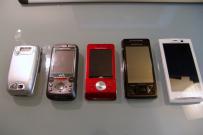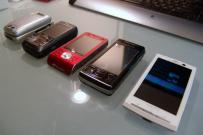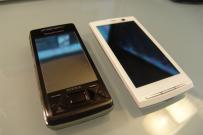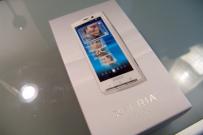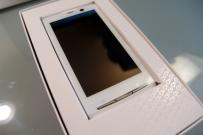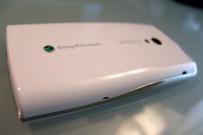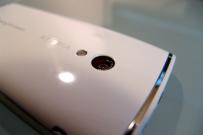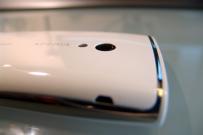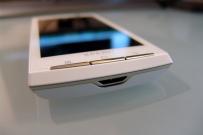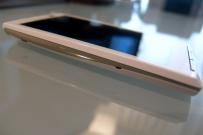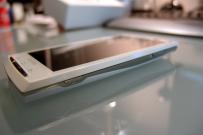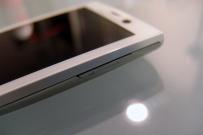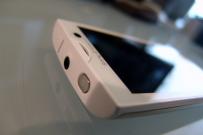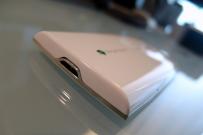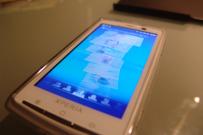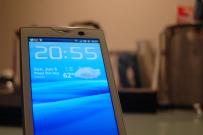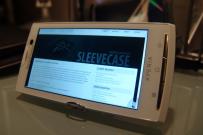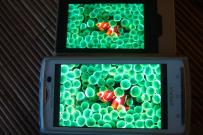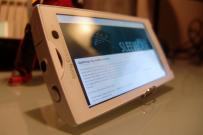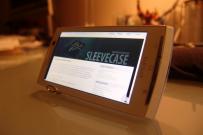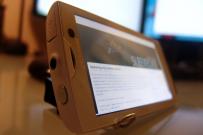Sony Ericsson Xperia X10 Mobile Phone

Introduction and History
Eighteen months ago, I began my transition from feature phone (Sony Ericsson W910i) to Smartphone Sony Xperia X1i. As a shameless fan of Sony Ericsson, I opted for the Xperia X1i based on wanting to better understand the Windows Mobile ecosystem and because the promised feature set was supposed to be game changing.
It wasn’t.
To be fair, it wasn’t as bad as you may think and my first Smartphone experience was mostly positive. As an active Microsoft Outlook user with my own hosted Exchange account, the Windows Mobile platform was actually a really great fit for keeping my email, calendar, and tasks synchronized. In fact, the Xperia X1 was an essential gadget for the planning and follow-through of my wedding and honeymoon.
So, what was missing?
As I started to use more features of the phone there were some glaring issues that became apparent to me.
First of all, the inability to take advantage of the 3G speed of the phone eventually became a handicap. Initially, it wasn’t an issue since T-Mobile had no 3G in my area. However, as T-Mobile USA’s AWS 3G network was built out, I was forced to live with EDGE speeds.
Secondly, the one thing that bothered me was that despite all the abilities of the phone, I always felt it was a step behind me. One way I would describe it is that it simply felt “slow†and despite being able to multitask, I found myself waiting for the phone to get things done.
Thirdly, the platform was not very exciting. One of the benefits of the Windows Mobile platform, a diversity of hardware selection and legacy support, is also its Achilles heel. Because there are so many variations of operating system, hardware form factors, and screen resolutions, there are less compelling applications available.
Lastly, the Xperia X1 had capable hardware and some unique features but Sony really did their customers a disservice by never helping the device fully reach its potential. The early firmware was buggy and seemingly half-baked; the device only really became very useful after using custom ROMs available from XDA Developers (which became a practice I did frequently).
With this in mind, I started looking late last year for a replacement. Coincidentally, the Sony Ericsson Xperia X10 was announced in November and it seemingly met my needs…on paper. The announcement created a lot of buzz in the blogosphere and it piqued my interest since it was the most powerful Android device announced at the time.
The only problem was it took them more than 5 months to actually ship the product and a crop of device launched with competitive features in addition to newer version of the Android OS. Even with this knowledge, I decided to give Sony Ericsson a chance and give in to the siren call of the Xperia X10. Would I be burned as an early adopter again? After two months of real world usage, it’s time to share my story but first, let’s see what attracted me to the phone in the first place.
Sony Ericsson Xperia X10 Mobile Phone
Marketed as Sony Ericsson’s flagship Android device, Sony Ericsson describes the product as the following:
· Sony Ericsson XPERIA™ X10 introduces an open and integrated world of social media, communication and entertainment.
· XPERIA™ X10 is the flagship phone in a family of phones coming to market during the first half of 2010. The XPERIA™ X10 will be available in Q1 2010.
· New UX (user experience) platform lets consumers organise everything and discover more with the most open, human and intuitive user experience yet.
Source
Those are pretty bold statements. To backup these expectations, Sony Ericsson has equipped the Xperia X10 with some pretty powerful hardware.
Specifications
- CPU: Qualcomm Snapdragon QSD8250 1GHz CPU
- 384MB of System RAM
- 1GB NAND Flash
- 8GB (or 16GB) Class 2 microSD included. The device supports up to 32GB.
- Android OS 1.6 “Donut†with custom UX (User Experience)
- 4†854x480 pixel (FWVGA) TFT Touchscreen capable of 24-bit (16 million) color
- 1500 mAh Lithium Polymer Battery (BST-41)
- 8.1 MP camera with auto focus, face recognition, geo-tagging, image and video stabilization, smile detection and touch focus
- Quad-band GSM/GPRS/EDGE - 850/900/1800/1900Mhz
- Tri-Band UMTS HSPA 900/1700/2100Mhz (international model) or UMTS HSPA 800/850/1900/2100Mhz (Americas/Australia model)
- Bluetooth 2.0 with A2DP, 802.11b/g wireless internet, aGPS, 3.5mm audio jack, microUSB port
- Dimensions: 119 x 63 x 13mm @ 135g (4.8 oz)
The hardware alone is not differentiating feature of the Xperia X10. Instead, Sony Ericsson has introduced a new UX (User Experience) platform to run on top of the standard Android interface. This initial version of the platform focuses on multimedia and social integration with new features and capabilities being added over time. Now, let’s look at the actual device.
First Impressions
I’ve always felt that higher-end Sony Ericsson devices to be of high quality. There’s almost always a certain level of fit and finish and the Xperia X10 is no exception. The body, a combination of plastic, glass and metal, is beautiful to behold and carries an air of stylish elegance. While some people may automatically equate the use of plastic with cheapness, I think they’ll be pleasantly surprised with how the device feels in hand especially with its curved back. Weighing in at 135g (4.8 oz), the device feels solid when held with the right amount of heft for the size.
This combination of the materials doesn’t seem to affect the strength of the chassis and the Xperia X10 easily stands up to my pressure test. I applied a decent amount of force (squeezing the device hard) all over the device and listen for a “creaking” noise and to my delight there was none.
I also appreciate the lanyard loop hole. A lot of phones don’t have these anymore and I think they’re more important now than ever since these devices get used all the time and the cost of replacement is not cheap.
Screen
The Xperia X10 has a scratch resistant mineral glass screen. To my surprise, my unit also came with a screen protector pre-applied. I don’t know if this is standard across all regions or markets but I found this to be a nice touch.
Speaking of the TFT screen, it’s absolutely gorgeous and crazy bright. At 4 inches in size, it’s very comfortable to read and it’s really the first size where I feel comfortable watching visual media on it. Despite the current 16-bit color (65,536 colors) limitation due to Android 1.6, the colors are surprisingly vibrant. The screen can produce 24-bit color (16 million colors) and will do so when the phone is upgraded to Android 2.x. I typically leave the device on automatic brightness settings since it does a good job of setting the appropriate brightness even when I’m outside.
There’s no AMOLED here and for now, I think it’s a great decision. While I’m a huge fan of OLED technology, the technology doesn’t work that well outside in bright daylight or overcast conditions. I find the Xperia X10 to be very readable compared to other touchscreen devices I have like my ZuneHD.
The capacitive touchscreen itself is pretty responsive and behaves as you would expect. I consider the iPhone’s touchscreen to be the best-in-class and in comparison, I’d say the Xperia X10 holds it’s own but it’s definitely not better. In fact, it’s pretty good considering the screen is not multi-touch capable.
Onscreen Keyboard
The Sony Ericsson supplied soft-keyboard is HORRIBLE. It really is. On the plus side, the layout and the convenient arrow buttons are nice; however, the responsiveness is very poor and some keys (on the outer edges) don’t register with any consistency. I don’t know how this slipped past the usability or quality assurance groups at Sony Ericsson. At first I thought it might be the touchscreen but it’s not. It’s the software. I have installed other 3rd party keyboards and they all work very well. My current favorites are SWYPE and the HTC keyboards.
Ports
There’s not too much to discuss since the device doesn’t have many. The 3.5” audio jack is standard and accepts regular stereo headphones as well as microphone-enabled headphones. I like how the micro USB connector is covered in terms of the aesthetics but I’m concerned about the long-term durability since I’m charging the device at least once per day.
Battery
One really interesting thing about the 1500 mAh battery is that it’s exactly the same model (BST-41) used in the Xperia X1 and Xperia X2. There are a couple of benefits here. First of all, it’s readily available and there are lots of accessories/replacements available. Secondly, it’s a good capacity battery and one of the better capacities on the market.
In terms of actual usage, I’ve found the battery essentially lasts one full day with my typical usage. This is acceptable. I’m always surprised by people who complain about this. It’s my opinion that anyone using a Smartphone nowadays should be used to charging their phone constantly. The more features your phone has, the more often you’re going to use it and battery life is going to suffer. If you really need to conserve battery then switching to the 2D EDGE connection can give you a better battery life. Wi-Fi and GPS usage can also drastically affect battery life so your mileage may differ.
User Experience
Sony, and Sony Ericsson by association, is never content with offering a plain, vanilla experience and is always looking to create its own interfaces. Like the Xperia X1’s Panel Interface, Sony has created some value- add software as a means of product differentiation. The centerpiece of the experience revolves around their Timescape and Mediascape applications.
Timescape is a communications aggregation tool which offers the user a means of quickly viewing feeds of their email, text messages, Twitter, Facebook, voice calls, and photos. The essence of Timescape is the concept of the spline. All forms of information are available on the spline and splines can be viewed per information type. It’s a fun way to visualize your communications; however, sometimes it’s not very useful since you can be easily inundated by the amount of information and each item on the spline only displays a little information. So, it’s great for a quick glance but you’ll end up having to open up the corresponding application if you want the full message.
Mediascape works similarly to Timescape by bringing photos, videos and music files together into a single interface. When you first launch it, you’re presented with a thumbnail view of recently used and recently added along with other lists. I found the interface to be usable but I feel like some interface elements are too small and could use larger tap targets. The playback of media is pretty flawless so my complaints are minor.
Other Software
I mentioned earlier that I’m an Exchange/Outlook user and while Android 1.6 doesn’t natively support Exchange, Sony Ericsson has kindly included a full copy Moxier Mail (regularly $24.99 USD) for full Exchange ActiveSync abilities. It syncs mail, contacts, calendar and tasks all over the air so that I’m always in sync with my laptop and desktop. Minimal fuss and I like it.
Camera
In my experience, the Xperia X10 has the best camera I’ve ever used on a mobile phone so far. It’s the first one that actually feels like a regular, if basic digital camera. Will it replace a dedicated digital camera? Not likely.
One thing you should know is that the Xperia X10 doesn’t have flash. Rather, it has a photo light. The difference is that you have to manually turn on the light via the advanced menu. This means you can use the light while framing your subject and while filming video. The only problem is that the light is somewhat anemic so you’re subject will have to be fairly close for it to be effective.
As with most phone cameras, you get the best results during the daytime. My only complaint is that the startup time is a little slow and there is a slight lag when you switch from portrait to landscape shooting since the interface re-adjusts to the orientation.
The video camera feature allows you to capture WVGA (840x480), VGA (640x480), QVGA (320x240), MMS (160x120) and Youtube. Unlike my Xperia X1, I found that the device was able to record and playback any of the allowed resolutions flawlessly. The audio portion is recorded mono. The day after I received the Xperia X10, I was able to test the device at an MC Hammer (Yes, THAT MC HAMMER) concert.
Multimedia
Multimedia duties are handled by Sony Ericsson’s custom Mediascape application which handles videos, photos, and music. My only gripe with the software is that the main interface only works in portrait mode except when you’re playing media (except for audio files). Other than that, Mediascape offers a pretty friendly experience and the standard codec support is decent.
Video playback performance is phenomenal. Codec support is limited to MPEG4, H.263, H.264, and WMV standards. If a lot of your content happens to be in H.264 or WMV format and then Xperia X10 does not disappoint. Not only can it playback DVD-quality (480p) content but also 720p HD content as well! I converted an AVCHD clip from my digital camera and got the resulting H.264 MP4 (1280x720 @ 30 fps ~ 3Mbps) file to play smoothly. Impressive!
I tested audio with two sets of headphones: the included headphones and my reference headphones (Etymotic ER6i noise isolating headphones). The Etymotic ER6i’s provide a flat response and provide a clear, less “biased†sound of the actual device. In general, audio playback is very good and clean. Bass can be a bit punchy at times but the treble is always clear and bright. The included headphone set is actually surprisingly good and they emphasize the bass a little bit more. They’re not the most comfortable headphones, but they don’t sound cheap either.
The audio player portion of Mediascape looks pretty nice and only plays in portrait mode. The homescreen shows you various different quick lists of your music and you can drilldown further to sort through your music. On the player screen itself, in addition to your standard playback buttons, you can do all the usual things like repeat, shuffle, favorite, send, and find other related songs from the interface. Calling up the contextual menu allows you to delete, set as ringtone, get more information, or download album art.
The photo player is also straightforward. You can view photos you’ve taken as well as integrate with Picasa Web Albums and Facebook Albums. This section works in either orientation so you can view images comfortably.
Sony Ericsson provides MediaGo software for free which provides media synchronization. It’s better than their previous software and it works. You can also use DoubleTwist for synchronization.
Connectivity
Xperia X10 offers Bluetooth 2.0 + EDR, 802.11 b/g Wi-Fi, and 2G/3G cellular connections.
The Bluetooth simply works. I’ve been able to pair the phone to three computers, two phones, various Bluetooth headsets, and hands-free car kits. I like the fact that when I send files to and from my laptop, the files are placed in the appropriate folders (e.g. videos, photos, music) without my intervention. Love it.
Wi-Fi also just works and I’ve had no trouble to connecting to open and secure networks.
Luckily for me, the international Xperia X10i model supports T-Mobile’s AWS 3G network in the United States and allows me to take advantage of the 3G speeds. On average, my ping times are 100ms and I get around 3.35Mbps down and 1.3Mbps up. In some areas, I’ve seen the download peak at 4.46Mbps which is not too shabby! I can finally watch Youtube videos in high quality.
Things I Would Change
Camera: I’d like to see Sony Ericsson take the lead and start implementing a wider angle lens on the camera. A lot of use cases involve close quarter shooting (e.g. taking self-shots of shots of friends, etc) and a wider angle would help take more dynamic shots. A forward facing camera would be nice too. My last three Sony Ericsson phone had this so it’s weird to not have it.
Flash: The flash needs to be addressed in future products. There should be the ability to act like a regular flash and also just be a video light but I know this is OS related. I wouldn’t mind an upgrade to Xenon LED or dual LED setup.
OS: I would be remiss if I didn’t mention that Sony Ericsson needs to keep up with the OS updates a lot faster. I understand the value proposition of creating a unique experience, but Sony Ericsson’s flagship device should have the latest and greatest. Sony Ericsson’s insistence on creating their own value-added features and interfaces, while noble, always gets them in trouble since they have an awful track record (i.e. Panels on the Xperia X1) in the execution and timely release of their products. Their value-add software has NO value if a new OS update comes out with a equivalent feature in addition to better performance and even more features.
Multi-touch: I only mention this because I found it odd that Sony Ericsson would ship a device without it since most devices in this class have it on their feature checklist.
microUSB: I love the standardization of the port; however, it would be nice if it was located on the bottom or side so there could be a charging stand for the device.
Who This Product Is For
I won’t lie. The Xperia X10 is NOT for everyone. Technology savvy or cutting edge enthusiasts will likely want to stay away since this product is not currently running the latest Android OS (currently 2.2) and there are a lot of alternatives available if you need to be on the bleeding edge. Also, other than the camera and the design (maybe), the Xperia X10 doesn’t offer anything the competition doesn’t already have. While the Xperia X10 will eventually be upgraded later in September, chances are that it will always be a step behind the latest release due to its custom user experience layer.
Does that mean it’s not worth getting? Absolutely not.
If you ignore the operating system aspect then the Xperia X10 stands out as well designed product that offers a different Android experience that centers around social integration and providing a “better†Android multimedia experience with a big bright screen. If those things interest you then you might like this phone. The upside is that it can only get better once they release the next major update.
Final Thoughts
Overall, I’m pretty happy with the Xperia X10 especially when you consider where I was coming from before. Out of the box, the phone has some shortcomings but luckily, nearly all of them can be addressed using third party software available on the Android Marketplace or from Sony Ericsson.
My last two months using it has been great. It does what I need and I never have to “think†about it. It does what I want and it “just worksâ€. Of course, I don’t live in a bubble and I know Android 2.2 exists and what it offers but I have yet to feel like I’m missing out or I’m unable to use my phone. I think that’s a great sign this is a good product fit for me.
The lack of multi-touch may be an issue for some people but I don’t mind it at all. I didn’t have it before on my old phone so it’s not like I’m really missing out on any thing. Most of the applications I use don’t require it or have other workarounds that are equally effective. Will this change in the future? Maybe, but for what I need to do now, it’s a non-issue. Also, since the phone is unlocked and my plan is month-to-month, I have the freedom to move onto something else whenever I want.
I will be updating the review once future updates come out and will note what has changed. Until then feel free to comment or email me if you have future questions.
